
Produkt zgodny z normami: EN71, EN62115
Product complies with: EN71, EN62115
Produkt konform mit den Normen: EN71, EN62115
INSTRUKCJA UŻYTKOWANIA/
USER MANUAL/
BEDIENUNGSANLEITUNG
POJAZD AKUMULATOROWY
BATTERY OPERATED RIDE-ON CAR
BATTERIEBETRIEBENES FAHRZEUG
JEEP RUBICON
WAŻNE! Prosimy o uważne przeczytanie niniejszej instrukcji użytkowania przed pierwszym
użyciem produktu. Instrukcję należy zachować na wypadek potrzeby ponownego z niej skorzys-
tania.
IMPORTANT! Please read these instructions carefully before the first use of the product. This
manual should be kept for future use.
WICHTIG! Wir bitten um genaues Durchlesen dieser Bedienungsanleitung vor der ersten
Anwendung des Produkts. Die Bedienungsanleitung ist für den Fall der Notwendigkeit ihrer
erneuten Nutzung aufzubewahren.

Thank you for choosing the Toyz by Caretero JEEP RUBICON battery operated
ride-on car. You bought a modern, high quality product.
We are sure it will help your child in safe, harmonious growth.
We encourage you to learn about our full offer on our website: www.toyz.pl
Should you have any remarks about this product, feel free to share them with us.
Toyz by Caretero TEAM.
Wir danken Ihnen für den Kauf des batteriebetriebenen Fahrzeugs Toyz by
Caretero JEEP RUBICON. Sie haben ein modernes Produkt von hoher Qualität
erworben.
Wir sind überzeugt, dass es Ihrem Kind Sicherheit garantiert und es bei der
harmonischen Entwicklung unterstützt. Wir laden Sie herzlich dazu ein, sich mit
unserem vollständigen Angebot auf der Website www.toyz.pl bekannt zu machen.
Außerdem nehmen wir gern Anmerkungen und Hinweise zur Nutzung unserer
Produkte entgegen.
Toyz by Caretero MANNSCHAFT.
Dziękujemy za zakup pojazdu akumulatorowego Toyz by Caretero JEEP
RUBICON.
Kupili Państwo nowoczesny produkt wysokiej jakości.
Jesteśmy przekonani, że zapewni on Państwa maluchowi bezpieczeństwo i pomoże
w jego harmonijnym rozwoju.
Zachęcamy do zapoznania się z naszą kompletną ofertą na stronie www.toyz.pl.
Czekamy również na wszelkie uwagi dotyczące użytkowania naszych produktów.
Zespół marki Toyz by Caretero.

3
PL LISTA CZĘŚCI
1. karoseria
2. kabel AUX
3. przednia szyba
4. kierownica
5. koło
6. kołpak
7. lusterko boczne
8. siedzisko
9. koło zapasowe
UWAGA: Przed złożeniem samochodu należy sprawdzić, czy w pudełku znajdują się wszystkie wymien-
ione części.
1 pc
1 pc
1 pc
1 pc
4 pc
4 pc
2 pc
1 pc
1 pc
10. pilot
11. kluczyk
12. zestaw akcesoriów
13. maska samochodu
14. zderzak
15. górne światła
16. podpora górnych świateł
17. pokrywa pod siedzisko
1 pc
1 pc
1 pc
1 pc
1 pc
1 pc
2 pc
1 pc

PL DANE TECHNICZNE
akumulator
silnik
ładowarka
maksymalne obciążenie
czas użytkowania
prędkość
wiek użytkownika
PL INSTRUKCJA UŻYTKOWANIA
PL INSTRUKCJA MONTAŻU
OSTRZEŻENIA: Produkt może być złożony wyłącznie przez osobę dorosłą. Produkt nie jest odpowiedni
dla dzieci poniżej 3. roku życia. Przed pierwszym użyciem, koniecznie naładuj akumulatory do pełna
(około 10-12 godzin), w przeciwnym razie może dojść do nieodwracalnego uszkodzenia akumulatorów.
Pojazd powinien być zawsze używany pod nadzorem osoby dorosłej. Produkt zawiera małe elementy,
Pojazdu nie wolno używać w ciemności. Napotkanie przez dziecko niespodziewanych przeszkód może
być przyczyną wypadku. Pojazdu należy używać tylko w ciągu dnia lub na dobrze oświetlonym terenie.
Nie zaleca się jazdy po mokrych powierzchniach lub zboczach o nachyleniu powyżej 15 stopni. Nie
należy korzystać z pojazdu na zewnątrz w czasie opadów deszczu lub śniegu. Przed zmianą kierunku z
jazdy w przód/tył należy całkowicie zatrzymać pojazd. Regularnie sprawdzaj wszystkie połączenia kabli,
akumulatorów. Sprawdzaj wszystkie elementy pojazdu, czy nie uległy uszkodzeniu. Jeśli jakikolwiek
element pojazdu uległ uszkodzeniu, zaprzestań użytkowania pojazdu i skontaktuj się ze sprzedawcą. Jeśli
nie używasz pojazdu przez dłuższy czas, odłącz kable od akumulatorów. Bezpieczny okres użytkowania
produktu wynosi 3 lata.
4
12V 10Ah (1 sztuka)
12V 45W (4 sztuki)
wejście: AC220V, 50Hz, wyjście: DC12V 1A
35 kg
do 2 godzin po pełnym naładowaniu
3 - 5 km/h
3-8 lat
Odwróć karoserię do góry dnem.
Zamocuj zderzak w przedniej
części przykręcając go trzema
śrubami.
Odłącz silniki od karoserii. Nałóż je
na odpowiadające im osie i połącz
ponownie silniki z kablami wystają-
cymi z karoserii.

5
Na oś na której zamocowany jest silnik nałóż kolejno: koło, podkładkę,
przykręć nakrętkę i nałóż kołpak. Zastosuj do kazdego z kół.
Połącz kabel kierownicy z kablem wystającym z karoserii. Schowaj
kabel w rowku układu kierowniczego a następnie zamontuj kierownicę
nakładając ją na wsytającą z karoserii część.

6
Umieść przednią szybę nad deską rodzielczą. Nałóż maskę na karose-
rię i zabezpiecz całość zaczepami w karoserii.
Umieść lusterka w gniazdach po
bokach przedniej szyby.
Zamocuj podpory górnych świateł
po bokach bagażnika pamiętając o
wpuszczeniu wystających kabli w
kanaliki wewnątrz podpór.
Połącz kable wystające z podpory z
kablami górnych świateł. Zamocuj
poprzeczkę ze światłami na podpo-
rach.

7
Umieść pokrywę pod siedzisko
wewnątrz karoserii.
Połącz przewody zasilające
wewnątrz karoserii.
Umieść siedzisko nad skupiskiem
kabli, pamiętając o wyciagnięciu
pasów bezpieczeństwa na
zewnątrz. Zabezpiecz siedzisko
przekręcając blokady po bokach
siedziska
Zamocuj zapasowe koło na bagaż-
niku pojazdu.

8
PL FUNKCJE POJAZDU
PL FUNKCJE PILOTA
1. Jazda do przodu
2. Zmiana prędkości jazdy
3. Jazda do tyłu
4. Hamulec
5. Skręt w prawo
6. Skręt w lewo
7. Wyświetlacz prędkości
PAROWANIE PILOTA Z POJAZDEM
Wykręć śrubkę i zdejmij zaślepkę pilota. Umieść w pilocie 2 baterie AAA i przykręć
zaślepkę na swoje miejsce.
Pojazd powinien być WYŁĄCZONY. Przytrzymaj na pilocie jednocześnie przyciski jazdy
w przód i w tył przez przynajmniej 3 sekundy. Gdy dioda LED zaświeci się należy włączyć
pojazd. Teraz pilot powinien być sparowany z pojazdem.
przyciski sygnałów dźwiękowych
stacyjka na kluczyk
zmiana napędu
panel multimedialny
przełącznik sterowania
zatrzask pokrywy przełącznika
drążek zmiany kierunku jazdy
1.
2.
3.
4.
5.
6.
7.

opis problemu prawdopodobna przyczyna rozwiązywanie problemu
pojazd nie jedzie
pojazd jedzie powoli
zbyt niskie napięcie akumulatorów
uszkodzony akumulator
naładuj akumulatory do pełna
użyj włącznika zasilania
wymień akumulator na nowy
podłącz ponownie złącza kabli
napraw lub wymień silnik
popraw montaż koła
wymień bezpiecznik na nowy
wyłączone zasilanie
niski stan akumulatorów
zużycie akumulatorów
uszkodzona ładowarka lub akumulator
ładowarka nie podłączona
akumulatory nie naładowane do pełna
zużycie akumulatorów
poluzowane okablowanie
zużycie silnika
wyładowanie baterii pilota
uszkodzenie odbiornika
uszkodzenie silnikagłośna praca pojazdu
zacinanie się podczas jazdy
akumulatory nie ładują się
krótki zasięg
odłączenie kabli
uszkodzony silnik
poluzowanie tylnego koła
przepalony bezpiecznik
uszkodzenie silnika
nierówna nawierzchnia
przeciążenie
uszkodzenie gniazda ładowania
uszkodzenie nadajnika
zakłócenia elektromagnetyczne
pilot nie działa
pojazd poza zasięgiem
naładuj akumulatory do pełna
wymień akumulatory na nowe
wymień element na nowy
podłącz ładowarkę do gniazdka
naładuj akumulatory do pełna
wymień akumulatory na nowe
podłącz ponownie okablowanie
wymień silnik na nowy
wymień baterie na nowe
wymień na nowy
napraw lub wymień silnik
wymień silnik na nowy
używaj pojazdu na równej drodze
maksymalna ładowność to 25 kg
wymień gniazdo na nowe
wymień na nowy
oddal się od pola magnetycznego
podejdź bliżej do pojazdu
9
zmiana napędu

10
UWAGI DO ŁADOWANIA AKUMULATORÓW
• Przed pierwszym użyciem pojazdu, koniecznie naładuj baterie do pełna. Zawsze podłączaj najpierw
końcówkę ładowarki do gniazda ładowania, a następnie włóż wtyczkę ładowarki do gniazdka (ładowa-
rkę
może obsługiwać wyłącznie osoba dorosła, nigdy nie pozwalaj swojemu dziecku na używanie ładowarki).
• Kiedy pojazd zaczyna tracić moc (jeździ z dużo mniejszą prędkością, niż normalnie), koniecznie
rozpocznij ładowanie akumulatorów przed całkowitym ich rozładowaniem.
Ładowanie powinno odbywać się w sposób ciągły przez 10-12 godzin. Nie należy ładować akumulatorów
dłużej niż 20 godzin.
• Normalnym zjawiskiem jest nagrzewanie się akumulatorów i ładowarki podczas ładowania (max. 60°C).
• Nigdy nie załączaj pojazdu podczas ładowania akumulatorów.
• Do ładowania używaj wyłącznie ładowarki dostarczonej z pojazdem. Nie używaj innych akumulatorów niż
te dostarczone z pojazdem.
• Nigdy nie używaj nowych i starych baterii oraz baterii różnego typu jednocześnie (zasilanie pilota).
• Akumulatory powinny być ładowane przynajmniej raz w miesiącu, także wtedy, gdy pojazd nie jest
używany. Ma to zabobiec całkowitemu rozładowaniu akumulatorów i jego potencjalnemu uszkodzeniu.
• Nigdy nie doprowadzaj do zwarcia układu elektrycznego.
• Gniazdo zasilania znajduje się w karoserii nad pedałem gazu.
• Podczas ładowania PRZEŁĄCZNIK ZASILANIA powinien znajdować się w pozycji OFF.
ZAPOBIEGANIE POŻAROWI I PORAŻENIU PRĄDEM:
• NIGDY nie dokonuj zmian w instalacji elektrycznej. Manipulowanie przy instalacji elektrycznej może
spowodować porażenie prądem, pożar lub wybuch, a także trwale uszkodzić instalację.
• Nie dopuszczaj do bezpośredniego kontaktu pomiędzy zaciskami. Może to wywołać pożar lub wybuch.
• Nie dopuszczaj do kontaktu baterii lub ich części z jakimikolwiek płynami.
• Ładowarki nie należy otwierać. Nieosłonięte przewody i obwody elektryczne wewnątrz obudowy mogą
spowodować porażenie prądem.
• Hermetyczny akumulator kwasowo-ołowiowy należy poddać recyklingowi lub składować w sposób
przyjazny dla środowiska.
• Nie należy wrzucać akumulatora kwasowo-ołowiowego do ognia. Może dojść do wybuchu lub wycieku.
• Nie należy wyrzucać akumulatora kwasowo-ołowiowego do zwykłego śmietnika. Spalanie, składowanie
lub mieszanie hermetycznych akumulatorów kwasowo-ołowiowych z odpadami komunalnymi jest
niezgodne z prawem.
• Oddaj zużyty akumulator do lokalnego autoryzowanego punktu recyklingu akumulatorów
kwasowo-ołowiowych, na przykład do sprzedawcy akumulatorów samochodowych.
• Aby uzyskać więcej informacji na temat przyjaznego środowisku recyklingu i utylizacji akumulatorów
kwasowo-ołowiowych, skontaktuj się z lokalnymi organami odpowiedzialnymi za gospodarowanie
odpadami.
• Akumulator może ładować wyłącznie osoba dorosła. Przed użyciem należy naładować baterię!
PL ŁADOWANIE AKUMULATORA
PL UTYLIZACJA AKUMULATORA

11
10. remote controller
11. car key
12. a set of accessories
13. hood
14. bumper
15. upper lights
16. upper lights support
17. cover under the seat
1 pc
1 pc
1 pc
1 pc
4 pc
4 pc
2 pc
1 pc
1 pc
1 pc
1 pc
1 pc
1 pc
1 pc
1 pc
2 pc
1 pc
EN LIST OF PARTS
1. vehicle body
2. AUX cable
3. windscreen
4. steering wheel
5. wheel
6. hubcap
7. side view mirror
8. seat
9. spare wheel
WARNING: Before assembling the car, check that all the parts listed are in the box.

EN TECHNICAL DATA
battery
engine
charger
maximum load
time of use
speed
age of use
EN INSTRUCTIONS FOR USE
EN ASSEMBLY INSTRUCTIONS
WARNINGS: Product may only be assembled by an adult. The product is not suitable for children under
3 years of age. Before the first use, be sure to fully charge the batteries (about 10-12 hours), otherwise
the batteries may be irreparably damaged.
The vehicle should always be used under adult supervision. The product contains small parts, The
vehicle must not be used in the dark. If a child encounters unexpected obstacles, it may cause an
accident. The vehicle should only be used during the day or in well-lit areas. Driving on wet surfaces or
slopes greater than 15 degrees is not recommended. Do not use your vehicle outdoors in rain or
snowfall. The vehicle must be brought to a complete stop before changing direction from forward /
reverse. Regularly check all connections of cables and batteries. Check all vehicle components for
damage. If any part of the vehicle is damaged, stop using the vehicle and contact your dealer. If you are
not using the vehicle for a long time, disconnect the cables from the batteries. The safe working life of
the product is 3 years.
12
12V 10Ah (1 pieces)
12V 45W (4 pieces)
input: AC220V, 50Hz, output: DC12V 1A
35 kg
up to 2 hours when fully charged
3 - 5 km/h
3-8 years
Turn the body upside down. Fix the
bumper in the front part by scre-
wing it with three screws.
Disconnect the motors from the
chassis. Put them on the corre-
sponding axles and reconnect the
motors to the cables protruding
from the body.

13
On the axle on which the motor is mounted, put the following in
sequence: wheel, washer, screw the nut and put on the cap. Apply to
each of the wheels.
Connect the steering wheel cable to the cable coming from the body.
Hide the cable in the groove of the steering system and then mount
the steering wheel by putting it on the part sticking out of the body-
work.

14
Place the windshield above the dashboard. Put the mask on the body
and secure it with the hooks in the body.
Place the mirrors in the slots on the
sides of the windshield.
Attach the upper light supports to
the sides of the trunk, remembering
to insert the protruding cables into
the channels inside the supports.
Connect the cables coming out of
the support with the cables of the
upper lights. Fix the crossbar with
the lights on the supports.

15
Place the seat cover inside the
body.
Connect the power cables inside
the car body.
Place the seat over the bundle of
cables, remembering to pull the
seat belts outwards. Secure the
seat by turning the locks on the
sides of the seat
Secure the spare wheel to the boot
of the vehicle.

16
EN VEHICLE FUNCTIONS
EN REMOTE FUNCTIONS
1. Drive forward
2. Changing the travel speed
3. Reverse driving
4. Brake
5. Right turn
6. Turn left
7. Speed display
PAIRING THE REMOTE CONTROL WITH THE VEHICLE
Remove the screw and remove the pilot cap. Insert 2 AAA batteries into the remote
control and screw the cap back into place.
The vehicle should be turned OFF. Hold the forward and reverse buttons on the remote
control simultaneously for at least 3 seconds. When the LED lights up, turn on the
vehicle. Now the remote control should be paired with the vehicle.
beep buttons
key switch
drive change
multimedia panel
control switch
switch cover latch
direction change lever
1.
2.
3.
4.
5.
6.
7.

EN TROUBLESHOOTING
wyładowanie baterii pilota
uszkodzenie odbiornika
uszkodzenie nadajnika
zakłócenia elektromagnetyczne
pilot nie działa
pojazd poza zasięgiem
wymień baterie na nowe
wymień na nowy
wymień na nowy
oddal się od pola magnetycznego
podejdź bliżej do pojazdu
17
problem description probable cause solution
the car is not moving
the car is moving slowly
low battery voltage
damaged battery
charge the batteries fully up
turn the car on with the power switch
replace the battery with a new one
connect the cables back up
repair or replace the motor
adjust the rear wheel
replace the fuse with a new one
power is off
low battery voltage
batteries worn out
AC adapter or battery damaged
AC adapter not connected
batteries not fully charged
worn out
loose cables
damaged motor
RC batteries depleted
receiver damaged
damaged motor loud noises
jamming during driving
batteries do not charge up
short range
cables disconnected
damaged motor
rear wheel loose
blown fuse
damaged motor
uneven terrain
overloading
charging socket damaged
transmitter damaged
electromagnetic interference
RC not working
car out of range
charge the batteries fully up
replace the battery with a new one
replace with new one
connect the plug into a socket
charge the batteries fully up
replace the battery with a new one
connect the cables back together
repair or replace the motor
replace batteries with new
replace the receiver unit
repair or replace the motor
repair or replace the motor
use the car on flat surfaces
max. user weight is 25 kg
replace the socket with new one
replace the RC
move away from the EMI source
stand closer to the car
drive change

18
BATTERY CHARGING NOTES
• Before first use of the car, charge the batteries up fully. Always insert the adapter's tip into the socket in
the car first and then put the plug into the socket (the charging process should be always carried out by
an adult, never allow your child to use the AC adapter).
• When the car begins to lose power (moves much slower than usual), charge the batteries before they
become completely depleted.
Battery charging should last about 10-12 hours. Do not charge the batteries for a period longer than 20
hour.
• It is typical, that the adapter and the batteries become hot during the charging process (max 60°C).
• Never turn the car ON while charging the batteries. The POWER SWITCH must be turned in OFF
position when charging.
• Always use the AC adapter included with the car. Never use other batteries than those supplied with
the car.
• The batteries need to be charged at least once a month, even when the car is not being used. This is to
prevent from fully discharging and potential damaging the batteries.
• Never short-circuit the power layout.
• PREVENT FIRE AND ELECTRIC SHOCK:
• Use the only rechargeable battery and charger supplied with your vehicle. NEVER substitute the battery
or the charger with another brand. Using another battery or charger my cause a fire or explosion.
• Do not use the battery or charger for any other product. Overheating, fire or explosion could occur.
• NEVER modify the electric circuit system. Tampering with the electric system may cause a shock, fire or
explosion or my permanently damage the system.
• Do not allow direct contact between battery terminals. Fire or explosion can occur.
• Do not allow any type of liquid on the battery or its components.
• Do not open the battery. Battery contains lead acid and other materials that are toxic and corrosive.
EN BATTERY CHARGING
EN DISPOSAL OF BATTERY
• Your sealed lead-acid battery must be recycled or disposed of in an environmentally sound manner.
• Do not dispose of your lead-acid battery in a fire. The battery may explode or leak.
• Do not dispose of a lead-acid battery in your regular, household trash. The incineration, land filling or
mixing of sealed lead-acid batteries with household trash is prohibited by law.
• Return an exhausted battery to your local approved lead-acid battery recycle, such as a local seller of
automotive batteries.
• Contact your local waste management officials for other information regarding the environmentally
sound recycling and disposal of lead-acid batteries.
• The battery must be charged only by adult. Please charge the product before using!

19
DE LISTE DER TEILE
1. Karosserie
2. AUX-Kabel
3. Windschutzscheibe
4. Lenkrad
5. Kreis
6. Kappe
7. Seitenspiegel
8. Sitzplatz
9. Reserverad
HINWEIS: Bitte überprüfen Sie vor dem Zusammenbau des Fahrzeugs, ob alle aufgeführten Teile im
Karton enthalten sind.
1 pc
1 pc
1 pc
1 pc
4 pc
4 pc
2 pc
1 pc
1 pc
10. Fernbedienung
11. Autoschlüssel
12. Zubehörsatz
13. Motorhaube
14. Stoßstange
15. Oberlichter
16. Unterstützung der oberen Lichter
17. Abdeckung unter dem Sitz
1 pc
1 pc
1 pc
1 pc
1 pc
1 pc
2 pc
1 pc

12V 10Ah (1 Stücke)
12V 45W (4 Stücke)
Eingang: AC220V, 50Hz, Ausgabe: DC12V 1A
35 kg
bis zu 2 Stunden nach voll aufladen
3 - 5 km/h
3-8 Jahre
DE TECHNISCHE DATEN
batterie
motor
AC-Ladegerät Eingang
maximale Belastung
Betriebszeit nach dem Laden der Batterie
Geschwindigkeit
Alter des Nutzers
DE WARNUNGEN
DE INSTALLATIONSANLEITUNG
WARNUNGEN: Das Produkt darf ausschließlich von erwachsenen Personen zusammengesetzt werden.
Das Produkt ist für Kinder unter dem 3. Lebensjahr nicht geeignet. Vor der ersten Nutzung sind die
Batterien unbedingt vollständig zu laden (etwa 10–12 Stunden), andernfalls kann es zu einer unumkehr-
baren Beschädigung der Batterien kommen. Das Fahrzeug darf nur unter Aufsicht eines Erwachsenen
genutzt werden. Das Fahrzeug darf nicht in der Nähe von Treppen / öffentlichen Straßen / Fahrzeugen
oder an anderen Gefahrenstellen genutzt werden. Das Fahrzeug darf nur von einem Kind gleichzeitig
genutzt werden. Das Maximalgewicht des Nutzers beträgt 100 kg.
Während der Nutzung des Fahrzeugs muss das Kind auf dem Sitz sitzen. Ein Aufstehen während der
Fahrt muss verhindert werden. Während der Fahrt darf der Hebel zur Richtungsänderung nach
vorn /nach hinten nicht plötzlich betätigt werden. Es sind regelmäßig alle Kabelverbindungen und
Batterien zu überprüfen. Prüfen Sie alle Fahrzeugelemente auf Beschädigungen. Sollte irgendein
Element des Fahrzeugs beschädigt sein, dann ist die Nutzung sofort einzustellen und der Verkäufer zu
kontaktieren. Wird das Auto über längere Zeit nicht genutzt, sollten die Kabel von den Batterien
abgeklemmt werden. Der sichere Nutzungszeitraum des Produkts beträgt 3 Jahre.
20
Drehen Sie den Körper auf den
Kopf. Befestigen Sie den Stoßfän-
ger im vorderen Teil, indem Sie ihn
mit drei Schrauben festschrauben.
Trennen Sie die Motoren vom
Chassis. Setzen Sie sie auf die
entsprechenden Achsen und
verbinden Sie die Motoren wieder
mit den Kabeln, die aus der Karos-
serie herausragen.
Strona się ładuje...
Strona się ładuje...
Strona się ładuje...
Strona się ładuje...
Strona się ładuje...
Strona się ładuje...
Strona się ładuje...
Strona się ładuje...
Strona się ładuje...
Strona się ładuje...
-
 1
1
-
 2
2
-
 3
3
-
 4
4
-
 5
5
-
 6
6
-
 7
7
-
 8
8
-
 9
9
-
 10
10
-
 11
11
-
 12
12
-
 13
13
-
 14
14
-
 15
15
-
 16
16
-
 17
17
-
 18
18
-
 19
19
-
 20
20
-
 21
21
-
 22
22
-
 23
23
-
 24
24
-
 25
25
-
 26
26
-
 27
27
-
 28
28
-
 29
29
-
 30
30
w innych językach
- Deutsch: TOYZ EN62115 Benutzerhandbuch
- English: TOYZ EN62115 User manual
Powiązane artykuły
-
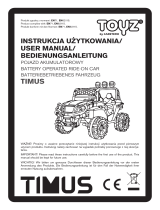 TOYZ TIMUS Battery Operated Ride On Car Instrukcja obsługi
TOYZ TIMUS Battery Operated Ride On Car Instrukcja obsługi
-
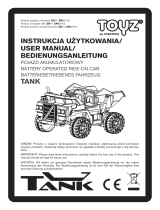 TOYZ TANK Battery Operated Ride On Car Instrukcja obsługi
TOYZ TANK Battery Operated Ride On Car Instrukcja obsługi
-
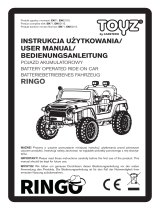 TOYZ EN62115 Battery Operated Ride-On Car Instrukcja obsługi
TOYZ EN62115 Battery Operated Ride-On Car Instrukcja obsługi
-
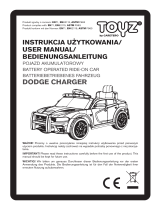 TOYZ DODGE CHARGER Battery Operated Ride-On Car Instrukcja obsługi
TOYZ DODGE CHARGER Battery Operated Ride-On Car Instrukcja obsługi
-
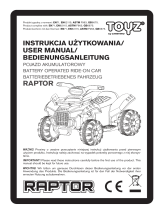 TOYZ MINI RAPTOR 6V RAPTOR Battery Operated Ride on Car Instrukcja obsługi
TOYZ MINI RAPTOR 6V RAPTOR Battery Operated Ride on Car Instrukcja obsługi
-
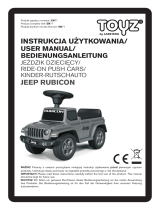 TOYZ JEEP RUBICON Ride On Push Cars Instrukcja obsługi
TOYZ JEEP RUBICON Ride On Push Cars Instrukcja obsługi
-
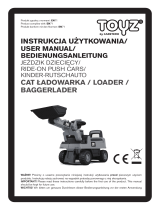 TOYZ Loader Ride On Push Cars Instrukcja obsługi
TOYZ Loader Ride On Push Cars Instrukcja obsługi
-
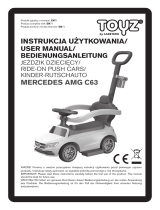 TOYZ MERCEDES AMG C63 Ride-On Push Cars Instrukcja obsługi
TOYZ MERCEDES AMG C63 Ride-On Push Cars Instrukcja obsługi





































